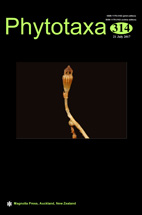Abstract
Dictyosporium wuyiense, a new anamorphic fungus collected on a dead branch of bamboo in Tongmugou, Wuyi Mountain, China, is described and illustrated. It is characterised by being cheiroid, septate, complanate, and yellow, with two types of conidia composed mostly of five parallel compact rows of cells, sometimes with variable hyaline apical vesical appendages. Type 1 conidia are longer and the three central rows are protruding with swollen apical cells; type 2 conidia are wider and fan-shaped, with rows of apical cells approximately the same length. The conidial morphology on potato dextrose agar plates was variable, most with 2–3 vesical appendages. In phylogenetic analyses of the internal transcribed spacer (ITS) of rDNA, Dictyosporium wuyiense clustered with most Dictyosporium species in Dictyosporiaceae, but was a distinct species. Both morphological and molecular evidence support its description as a new species. A brief review of Dictyosporium and allied species is provided.

